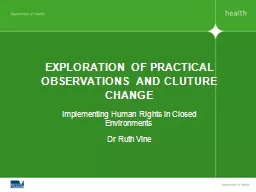

Implementing Human Rights in Closed Environments Dr Ruth Vine LOTS OF ISSUES SYSTEM CONTEXT beds open or closed are only part of the system of mental health care in prison setting and in the community ID: 796942
Download The PPT/PDF document "EXPLORATION OF PRACTICAL OBSERVATIONS AN..." is the property of its rightful owner. Permission is granted to download and print the materials on this web site for personal, non-commercial use only, and to display it on your personal computer provided you do not modify the materials and that you retain all copyright notices contained in the materials. By downloading content from our website, you accept the terms of this agreement.
Slide1
EXPLORATION OF PRACTICAL OBSERVATIONS AND CLUTURE CHANGE
Implementing Human Rights in Closed Environments
Dr Ruth Vine
Slide2LOTS OF ISSUES
SYSTEM CONTEXT – beds, open or closed, are only part of the system of mental health care, in prison setting and in the community
LEGAL CONTEXT – MHA seeks to balance competing rights when there are issues of mental illness and dangerousness to self or others. Involuntary treatment not permitted in prison environment where security/control is overriding issue rather than treatment
WORKFORCE – often uneasy balance between OHS expectations and patient autonomy/freedom of movement
Slide3ACCESS AND IMPLICATIONS
Inpatient care only when care in the community inappropriate.
1.2% of community access public MH, cf estimated prevalence of 10%
Strict eligibility criteria
>50% of inpatients involuntary
So people who are admitted are very unwell. Heavy demand on High Dependency beds
Forensic beds and SECU especially pressured
Slide4THE BED STORY
Year
Acute
Non-acute
Per 10,000
1992
965
922
4.2
2011
1050
184 (480)
2.3
Slide5CURRENT LONG STAY SERVICE ELEMENTS
SECU – 103 beds + 20 beds at Mary Guthrie –
clinical model, locked with leave, limited multi-disciplinary, 24/24, mostly male,
CCU – 336 beds –
clinical model, open, expected level of self care, limited multi-disciplinary, 24/24,
Acute – generally 10 – 15 ultra long stay (> 12/12) –
clinical model, intensive staffing, restricted environment, 24/24,
Forensic – 116 beds, of which 40 are acute
.
Long LOS – 24 hour intensive staffing.
Residential Rehabilitation – 103 adult through 9 sites, including youth = 173 –
PDRSS, sleepover or less, limited staff, expected self-care, daytime activity, mostly male
Pension level SRS – 66 with 1876 beds –
limited personal support, minimal activity.
Disability accommodation –
5 bed CRU – active night staff, no clinical support.
Prison -
. Mental health units at MAP, PPP, DPFC
Slide6COMPETING PRESSURES
Policy and practice effort to reduce coercive interventions like seclusion and restraint
Policy and practice efforts to increase throughput of beds, treat in community/mainstream prison whenever possible
Move to ‘recovery’ based care, autonomy and choice, but public concerned about community risk, suicide
Workforce arguing for more security, stronger response to assaults/abuse – eg ANF arguments for security guards
Increased demand, decreased funding. Victoria now near the bottom.
Slide7Slide8IMPEDIMENTS TO REDUCTION IN USE OF COERCIVE PRACTICES
Inpatient units often overcrowded with mixed use areas, little outdoor space, or areas to use as ‘time out’.
Inpatient admission often used as last resort so people admitted in very disturbed and agitated state.
Pressure on beds means that LOS is short, majority of patients still in very acute phase
Staff are risk averse – need to be aware of safety of other patients and staff
Staff may be relatively junior. Often experienced staff work in the community, while inpatient units are the training ground. They do offer the place where there is most supervision
Leadership – all professions not engaged in process
Slide9Key Learnings - Victoria
All staff have a role to play in the culture of the organisation
Leadership within IPU must be multi-disciplinary – must involve medical, nursing and allied health
Rigorous review and audit processes relating to the use of seclusion and restraint support practice change
Experience of consumers and carers is integral to systems improvement and change
Physical environment and therapeutic milieu must be regularly assessed
Training needs to address prevention and early intervention- de-escalation, defusing, as well as how to manage restraint and seclusion
Helpful to make this something whole organisation – CEO included – commits to and has to report against
Slide10IS THERE A SOLUTION?
Monitoring, oversight, public reporting and effort (leadership) remain important.
Legislation to reflect and drive practice change important, but conflict between autonomy and early intervention in some mental illness
But capacity needs to grow – a bit, even if not in line with population, prisoner numbers
Workforce critical. Inpatient units, prisons seen as lower status/less attractive than community settings
Design and layout impacts on environment and culture – compare a TEH unit with a civil acute unit.